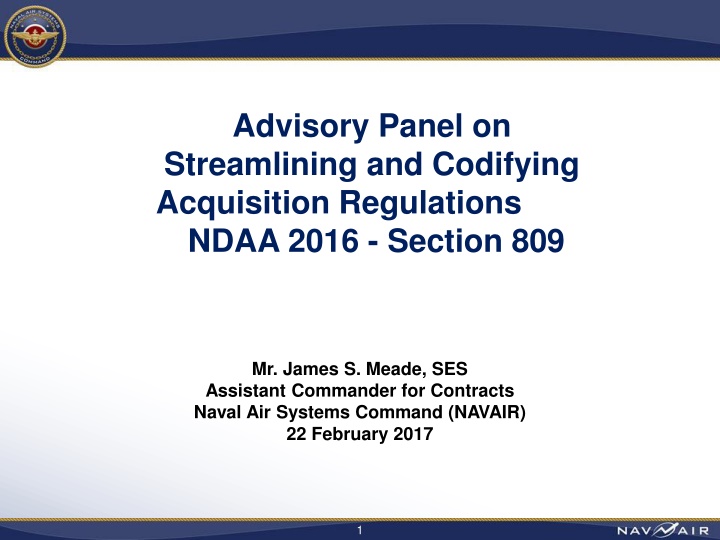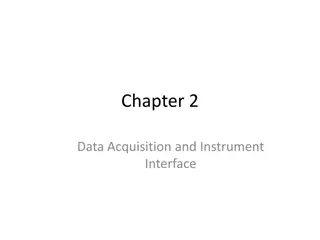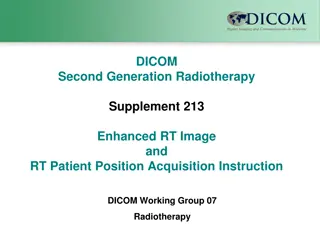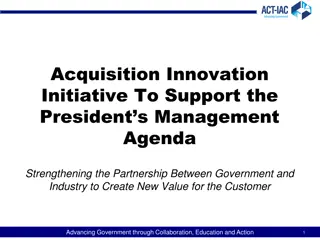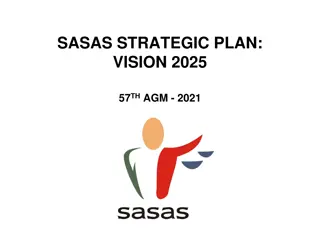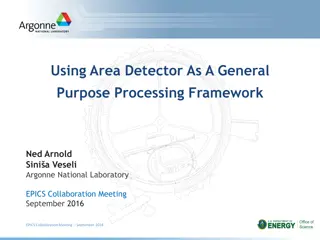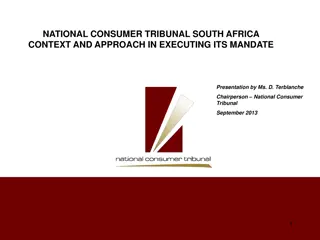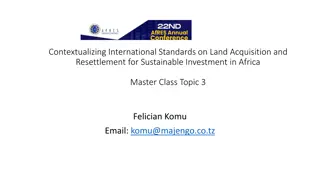NAVAIR Acquisition Realities and Strategic Imperatives
NAVAIR's Assistant Commander for Contracts, Mr. James S. Meade, provides insights on streamlining acquisition regulations and outlines his extensive background in contracts management. NAVAIR's mission is to support Naval Aviation operations for Sailors and Marines. The organization's strategic imperatives focus on readiness, capacity building, and resource alignment. Addressing acquisition challenges, they emphasize cost control, innovation in contract strategies, and the importance of competition.
Download Presentation

Please find below an Image/Link to download the presentation.
The content on the website is provided AS IS for your information and personal use only. It may not be sold, licensed, or shared on other websites without obtaining consent from the author.If you encounter any issues during the download, it is possible that the publisher has removed the file from their server.
You are allowed to download the files provided on this website for personal or commercial use, subject to the condition that they are used lawfully. All files are the property of their respective owners.
The content on the website is provided AS IS for your information and personal use only. It may not be sold, licensed, or shared on other websites without obtaining consent from the author.
E N D
Presentation Transcript
Advisory Panel on Streamlining and Codifying Acquisition Regulations NDAA 2016 - Section 809 Mr. James S. Meade, SES Assistant Commander for Contracts Naval Air Systems Command (NAVAIR) 22 February 2017 1
My Background NAVAIR Assistant Commander for Contracts (2014 - Present) Navy Senior Services Manager/ Executive Director DASN(AP) (2012 - 2014) NAVAIR Contracts (1987 - 2012) Senior Executive in contracts for PEO(U&W) (2004 - 2012) Missiles Division Head (2003 - 2004) Chief of Contracting Office, Naval Air Warfare Center, Aircraft Division (NAWC-AD) (2000 - 2003) F/A-18 PCO / Supervisor (1997 2000) Joint Standoff Weapon PCO (1993 - 1997) F/A-18 Contract Specialist (1989 - 1993) Tomahawk Contract Specialist (1987 - 1989) GSA Contract Specialist (1986) Earth Science Teacher (1985) Education Level III Certified in Contracting, Member Navy Acquisition Professional Community 1985 Master of Science, North Carolina State University - 1982 Bachelor of Science, College of William and Mary 2
NAVAIRs Mission NAVAIR's mission is to provide full life-cycle support of Naval Aviation aircraft, weapons and systems operated by Sailors and Marines. This support includes research, design, development and systems engineering; acquisition; test and evaluation; training facilities and equipment; repair and modification; and in-service engineering and logistics support. 3
NAVAIRs Strategic Imperatives Ready to Fight Tonight. Capabilities and Capacity to Win the Future. 1. Align resources to better support Current Readiness Fixing Existing Issues Predictive vice Reactive Tactical and Strategic 2. Increase Speed of new Capability to the Fleet Change program team staffing model (smaller and more empowered) Significantly reduce derived requirements Across the Board! Resource Rapid Response capabilities to maximum capacity (e.g. AIRWorks) Well understood risk acceptance, balanced at Command and Competency 4
Acquisition Realities Austerity is the word of the day (or is it decade?) We need to aggressively attack costs Should Cost / Will Cost / Actual Costs o Challenge requirements, non-mandatory clauses o Understand subcontractor proposals / Intercompany transfers o Actuals from our suppliers Innovative strategies o Ability to trade performance for cost? o Contract Type (FFP, FPI, CPI, CPFF) - Defense Pricing, DPAP, 2017 NDAA o Block Buys, Multi-year, Contract Options Competition is key to attacking costs o What data rights is the Government entitled to? Short and long term needs Proper marking of data o Can we obtain new technology / innovation without Intellectual Property (IP) constraints? o How do we shift services contracts to Outcomes vice Level of Effort? Utilization of Small Business Speed to the Fleet while balancing Statutes, Regulations, and Policy Live and Breathe Cost Consciousness, Speed 5
Service Contracting is Misunderstood Service contracts are necessary for our National Defense Not all service contracts are created equal, yet regulation and policy make little distinction whether you are buying engineering services to design a ship, running a test range, analyzing test data from a missile launch, answering phones, or emptying trash cans. Half of DoD s obligations are for services which implies we are not getting delivery of an actual product, yet ships and aircraft do not get designed, improved, supported and maintained without service contractors Simply put, service contracting is much more than just an augmentation of the federal workforce and plays a critical role improving readiness and providing capability and capacity to the fleet. 6 6
What is Working? Increased emphasis on Market Research Awards based upon initial proposals for Knowledge Based Services Emphasis on increasing prime contract opportunities for small businesses Requiring a Quality Assurance Surveillance Plan (QASP) or Surveillance Plan Use of Competitive Basic Order Agreements (BOAs) vice Multiple Award Contracts (MACs) BOAs can address areas of consideration where future known contracting requirements are highly speculative Use of streamlined Sections L&M for services competitions Objective is to reduce evaluation time, improve proposal quality, and provide more discrimination in non-price factors. Request less proposal information, such as resumes for non key personnel, increased technical factor discrimination though detailed sample tasks, and an emphasis to award on initial offers. Fair Opportunity Task Order (TO) competitions, very efficient with quick turnaround time on TO competitions Contracting Officer Representative (COR) qualifications and reviews Utilizing standard labor qualifications (education & experience) for professional labor 7 7
GSA OASIS Multiple Award Contract (MAC) Advantages: Strategically Sourced More rigorous pre-qualification of vendors supports FAR Part 16 streamlining Only 40-50 Primes in each of the 7 OASIS Pools (best of breed) Subcontractor registered not required Maximum flexibility Affordable, pay as you go usage fee based upon obligated award dollars Disadvantages: Strategically Sourced Small number of local small businesses hold prime contracts under OASIS, so they are limited to participating as a subcontractor Limited On-Ramp opportunities for new competitors 8 8
Why are we afraid to take Risks? How do contracting officers reduce cycle time, minimize source selection documentation, comply with all statues, regulations, and policies, get the best deal for the warfighter and still cover their six when a protest is submitted or congress and / or an Inspector General expresses concern? We need to build a culture focused on mission execution and speed rather than risk avoidance 9 9
Improvements Why have an acquisition planning document, such as the Navy s Management and Oversight Process for the Acquisition of Services (MOPAS), for contract actions under $50M FAR Part 7 threshold? (DFARS Part 207.103(d)(i)(B), NMCARS 5237.503) FY17 NDAA Section 829 requirement for approval by Component Acquisition Executive (CAE) for use of cost type contracts over $50M, dropping to $25M PCO has best understanding of the market Counter to AT&L policy memo stating a CPFF Term LOE type is typically the best contract type for Knowledge Based Services Possibility of a return to Time and Material Contacts Is there an opportunity to delegate the approval level and/or provide a deviation to this approval requirement? Makes little sense for Engineering, Manufacturing, and Development (EMD) contracts FY17 NDAA changes to not evaluate price when establishing MACs (section 825); increased micro-purchase threshold applicable to DoD procurements to $5,000 (section 821); and increase in Fair Opportunity Protest threshold up to $25M for DoD MACs (section 835) 10 10
Improvements Continue to develop standard work package for statements of work and performance work statements. Reduce touch points/layers of review Delegate DoD 5000.74 approval levels to no higher than Chief of Contracting Office (CCO) for all services under $1B; HCA for services greater than $1B Don t treat routine services buys like a major hardware acquisition Use FY17 NDAA Section 803 to force simplification of DoD Instruction 5000.74 Continue to improve the development of procurement packages Reduce / simplify set aside mandates (FAR Part 19) Continue to establish command level multiple award contracts for Program Management Services, Logistics Support, etc. to further increase speed Eliminate acquisition strategy requirement for services actions under $50M or at minimum, streamline MOPAS FY17 NDAA Section 822 will require all single bid competitions to be negotiated. We need to go back to relying on the "aura" / threat of competition standard backed by a solid price analysis to avoid negotiations and increase to schedule. 11
Improvements Acquisition Cells Continue to recruit, educate, and train acquisition teams and contract specialists Section 852 funding is key Expedited Hiring Authority (EHA) Hire more Contract Specialists; we have a great return on investment! Find ways to minimize Race-to-the-Bottom Cost plus incentive fee provisions for cost incurred RFP labor cost ranges (i.e., minimize low bids) Protest reform may give Source Selection Officials greater flexibility to pay premiums (i.e., best value) without fear and or excessive documentation Ability to routinely extend high performing contracts (i.e., performance options) Continue/expand outreach to services contract community; establish better communications such as long range forecasts, pre Request For Proposal (RFP) discussions, and clarifications Continue to solicit industry inputs on efficiency recommendations Reduce documentation requirements. For example, new Navy Acquisition Plan to include only the essential minimums. 12
Improvements Standard Tools can be difficult to use Fix the eCMRA Tool many contractors have reported difficulty using the web- based system, data is suspect Fix the DoD CORT tool onerous to use, inflexible and frequently inaccessible SPS can t handle contracts with large number of CLINs, modifications FAR 52.222-46 Evaluation of Compensation for Professional Employees Industry has challenged our ability to compare the instant offerors proposed compensation levels to those of the predecessor contractor Confusions as to when it applies, no clear definition of a Professional Employee Limits Competitive Marketplace Protests too many; common practice for losing incumbent to protest because they will typically be able to continue performance during the protest period Prohibit protest for all contracts under $25M or Expand use of alternative dispute resolution vice GAO for protests on all DoD contracts under $25M (revise GAO Bid protest Regulations, 4 CFR Part 21, 21.10(e) ) 13 13
Improvements Too many duplicate statutes, regulations, and policies President Trump s Executive Order deleting two old regulations for every new regulation is a good start Need standard policy on using Task Descriptions/Technical Direction Letters to authorize separate projects (Cost/Schedule/Performance) on a definitive contract (C-type) or on a Task Order (16.504 Indefinite- quantity contracts) Audit compliance and numerous appropriations adds complexity Multiple customers and appropriations on a single contract adds CLINS, increases complexity of execution and management of contract Purpose/Time/Amount compliance on contracts with multiple appropriations and sponsors; what is good enough from a CLIN/SOW alignment standpoint? Exempt Personal Assistant Services, generally used as part of a reasonable accommodation for folks with a disability, from personal services funding limitations 14 14
Improvements Single Award Determination and Findings: The determination required in FAR 16.504(c)(1)(D)(i) that the task orders under the contract are so integrally related that only a single source can reasonably perform.. has been interpreted as a very high standard to meet; thus, in the absence of that approval, less than optimum alternatives such as using C-type contracts or breaking up IDIQ contracts into smaller IDIQ contracts to remain below the $113M threshold can become necessary. For Knowledge Based Services, remove FAR Part 37.6, 237.170.2, and 5237.170 preference for performance based Revise Chapter 1, Part B of the Joint Travel Regulations (JTR) to allow DoD travelers to book alternative accommodations via sites such as AirBNB and VRBO 15 15
